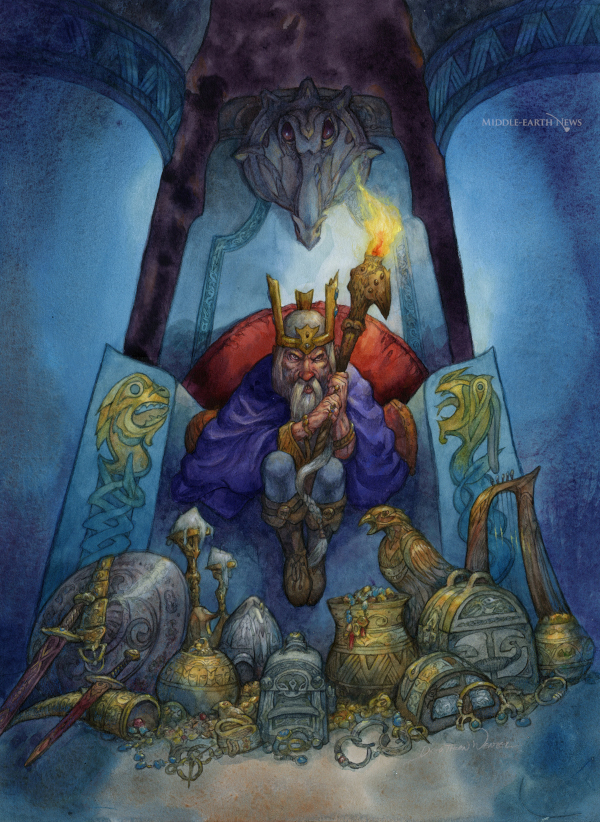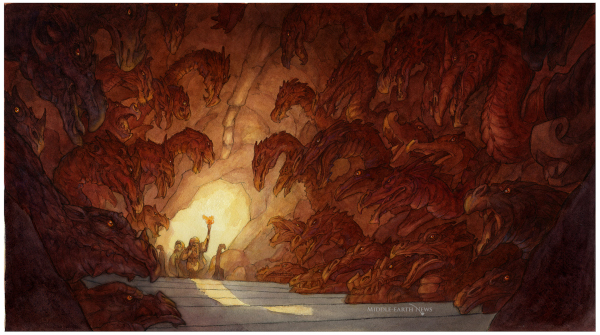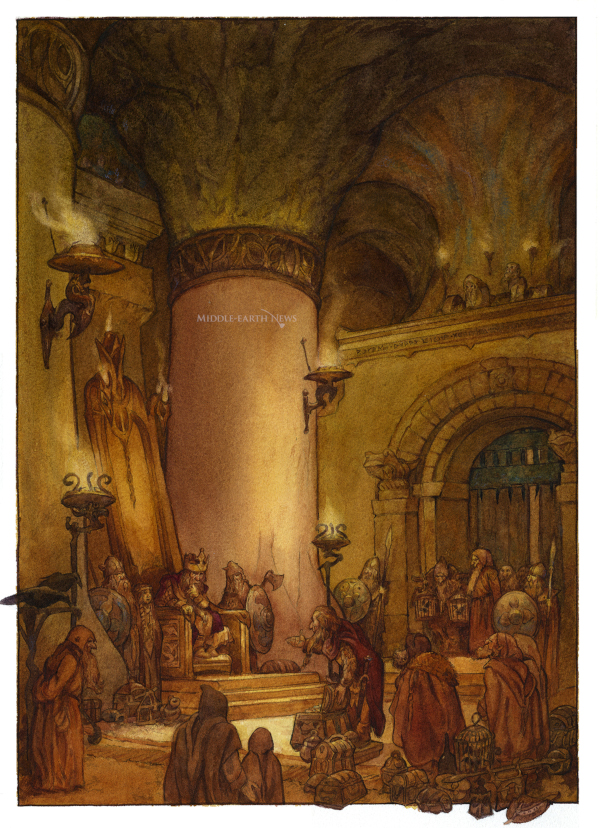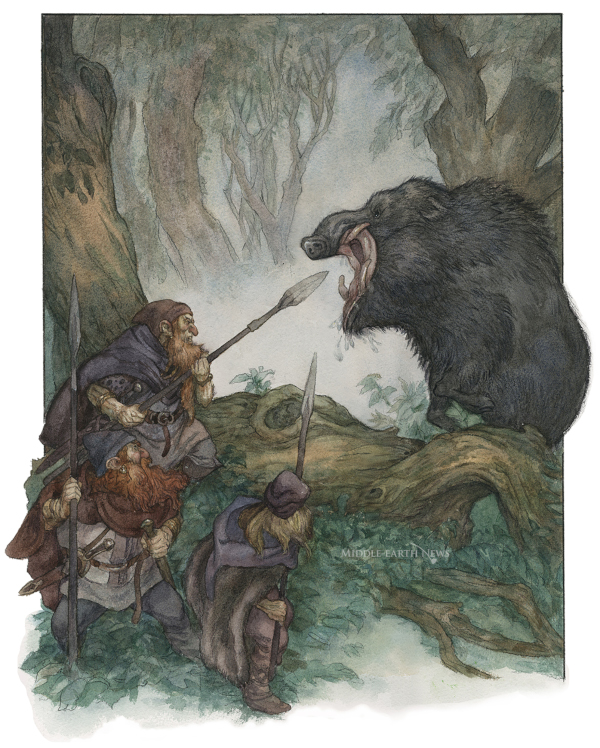This interview occurred during Dragon Con 2018. Mr. Wenzel returned to Dragon Con in 2019. This article combines material from the 2018 interview and Mr. Wenzel’s 2019 panel.

David Wenzel: The idea behind Kingdom of the Dwarfs was that I’m hoping most of the people who read The Hobbit want to escape to that world. I mean, I remember when I first read it—literally when I’d go to bed at night, I’d say, “Oh, I’m having trouble sleeping. What would it be like to walk around the Shire?” or something like that. So, I wanted to bring that world somehow into our world. The original idea—the germ of that idea—was based on “What if one of the races from Middle-earth actually existed in our world?”
But it couldn’t be elves, because the elves are so different in how people describe them throughout our folk tales, and obviously ents or all those things would be off the board. But the one thing that Tolkien really pulled from our past was the dwarves. And his dwarves are very much like the dwarves from the Scandinavian mythology. So my thought was, what if they found an archeological site that showed that this vast history of dwarves had been around, had survived loosely to the Middle Ages but had been dominant in early history, and that, how did it get covered up? So, how did many things get covered up? So, if you think about the past, the Norse tales would all have disappeared if it weren’t for the fact… Well, they disappeared except in Iceland. Because everywhere else, the Christian church destroyed them. So I always thought, well, what if the Christian church from back then decided that the dwarves were rebellious against that whole concept and just obliterated their past and took it out of the textbooks and, in fact, changed it into [the dwarf characters from folk tales]. If you think about the characters from the dwarves that go on, Rumpelstiltskin is a very good example, or there’s a character called King Lot, and then there’s several in the book [The Kingdom of the Dwarfs], the story of King Herla who was totally tricked by the dwarves. So it tied in the cruelty of history. When I started researching history, the first thing we arrived on was Piltdown Man. Piltdown Man was the hinge that made the archeological site disappear. Because all those British archeologists’ careers were destroyed when they misidentified that skull. So the concept behind the book is they send this archeological team, which I was part of to make sure this is a legit dig. However, the head archeologist, Dr. Dvaergen disappears, so they never, ever report it. He disappears, so everything goes off the board. But, it shows how they tie in. And it ties in with the anomalies of archaeology. Archeology — if you look at the history of our archeological past — has so many anomalies in it.

This is when I redid the book. The new book has tons of new pages, I wrote a whole bunch of stuff, so I became part of the writer of the book, which I’m real excited about. But the anomalies of history are really interesting. And what started to occur to me, and it has for a long time, that archeology is based on if they find writing or if they find sites… but essentially they wing a lot of archeology. I love ancient Rome, and when you start reading about ancient Rome, you realize how many of the writers that were writing then were influenced by whoever they were close to. So they changed things. So it offered me the opportunity to go, “Where are the holes in history?” There’re holes in history that, if I put them in the book, they would prove there were dwarves. Do you know that there are miles of tunnels under Europe that are like three feet tall? Now, they don’t interconnect, like some people say, but they’re there. And many of the tunnels are three feet tall. So who’s going through a tunnel three feet tall for miles? Dwarves. Then the Vikings created this sword, the Ulfberht sword. This sword, the metallurgy in it was so far beyond what was at the time that it wouldn’t be for a couple hundred years before they came up with the technology to make these swords. Interesting, because the dwarves were supposed to make a lot of swords for the Vikings. And then there’s the other, third, anomaly, which really led me to believe that maybe I’m writing the truth [laughs]. Göbekli Tepe is a site they found in Turkey in the late 1990’s, I think. But when they explored it, it was before the pyramids, before man had pottery; it was before man had developed metal tools, yet it has intricate stone carvings. They have no idea who made it, how they made it, particularly how they made it, and of course I know — the dwarves made it.

Valdís: What motivated you to do the new edition now?
David Wenzel: I’ve been sitting on it for a long time. And like any artist, I’d look back at the work and go, “Gee, this is a great, great, idea.” And my style had changed over the years. So when I first did the original book, I was doing a lot of pen and ink, and the printing techniques back then were in that we had to print black and white, and then even the color pieces, I would do a black and white piece, but I would have to do a color section, which would be dropped in by the printer. So now I had the ability to create a lot of color work, with the advent of the four-color press now, so I can make the whole book in full color. So that was one of the incentives to do it. But I really wanted to revisit it because I had other ideas about what would translate into fun parts of the story.

Valdís: You mentioned already some changes between the first edition and the new edition. Can you expand on that a little bit?
David Wenzel: Yeah, yeah. So the core of the writing of the first edition is still there. The core writing sort of tells a story, but I wanted to pull these little call-out parts into it so that people would relate more to the little tidbits [to work in little bits of history]. One for instance is how dwarves made charcoal to run their furnaces. [Another] is that during the Middle Ages, they walled off the towns. I mean, that’s real common, the towns were walled off because of protection, [from] roving bands of robbers, so they walled off the towns and nobody went outside the town. Well, in the forests at night, nobody’s around, [so] that’s the time they [dwarves] could go out. So I made a point of pointing out how they walled the towns off. It’s really a quick little thing.

Valdís: So you have the graphic novel of The Hobbit, and you have The Kingdom of the Dwarfs. Are there stylistic differences in how you drew the dwarves in one story versus the other?
David Wenzel: Yeah. That’s a really good question. So, the dwarves in The Hobbit… I did a lot of sketches, preliminary work, but they were more of a children’s book. They weren’t exactly, because at the time I was thinking, if the publisher wanted to do Lord of the Rings I wanted to be able to change, because the dwarves in The Lord of the Rings are a little more serious than the dwarves in The Hobbit. The dwarves in The Hobbit aren’t silly; they’re not as adept as the dwarves in Lord of the Rings. So when I did the dwarves in Kingdom of the Dwarfs, I made more of them gnarly and scruffy. There’re a lot of similarities, but they’re not exactly the same. The other thing is when I did the new book, the new art, I realized that I had made the original dwarves in Kingdom of the Dwarfs have really short legs. And when I was drawing dwarves now, I was extending their legs a little. That’s one change in general. There was a bunch.

Valdís: I can’t wait for the new edition! I have the first edition.
David Wenzel: They’re going to be different! You can see by looking at the art.
Valdís: Yeah! I’m super excited. Is there anything else you want to tell us about the new book, or what’s coming next? The next project?
David Wenzel: I’m not sure what the next project is going to be. I’m going to ride Kingdom of the Dwarfs for a while. Believe it or not, the next project I want to do has nothing to do with Tolkien, but it’s related to fantasy, in that for years I have been working on a book, which I have various pieces of, and it’s gone through many forms. I have always loved the idea of the secret society of Santa’s elves, which you never see in your house. That they’re hiding in your house. And I want to do a book of how they manage to keep track of every kid. And, again — they’re Santa’s spies. They’re tiny, and they know how to hide, and they screw with your house, too. And you never see them. How do they camouflage themselves, how do they blend in? I’ve worked this book out many different ways. I think that would be a lot of fun.
Valdís: It sounds like a lot of fun! That’s great! I love it!
David Wenzel: So that’s one thing. And I have a couple graphic novels I’d love to develop. One is a space one, and one is a Kingdom of the Dwarfs related one.
Valdís: Thank you so much for your time!
You can find ‘The Kingdom of the Dwarfs’ now at your local bookseller or your favorite online merchant!
Amazon.com: The Kingdom of the Dwarfs, David T. Wenzel









